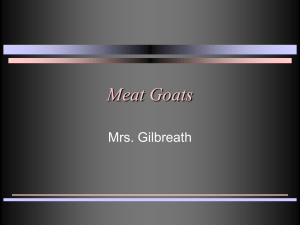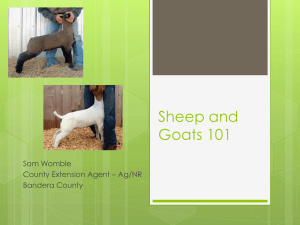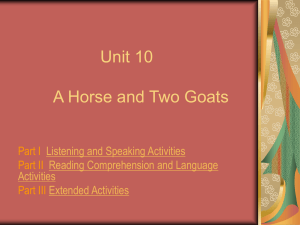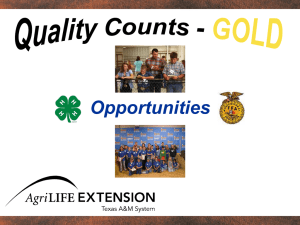Raising Goats and Chickens in an Urban Setting
advertisement
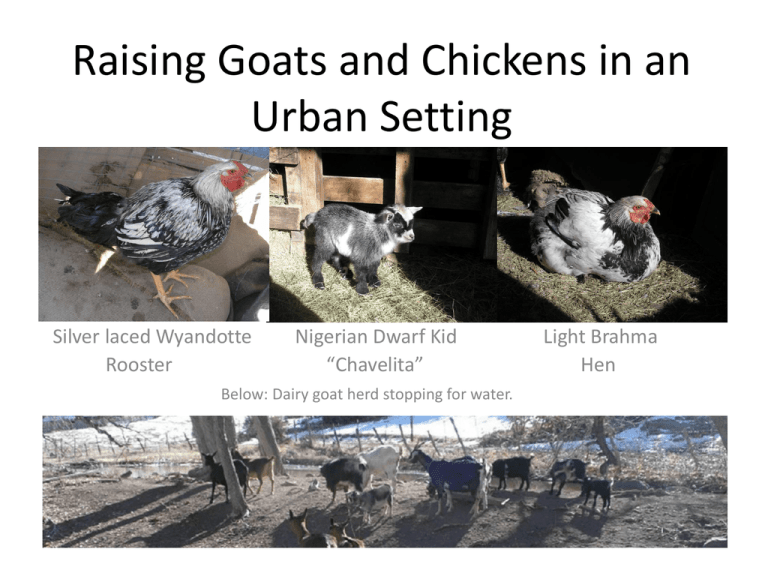
Raising Goats and Chickens in an Urban Setting Silver laced Wyandotte Rooster Nigerian Dwarf Kid “Chavelita” Below: Dairy goat herd stopping for water. Light Brahma Hen Sunny Hill & Kelly Hill ~ Co-owners of Dos Lomas Goat Company ~ Located in Northeastern New Mexico at the Rainbow Ranch ~ Bio: Sunny is a trained and accomplished chef, restaurateur, business owner and manager, and spent the early part of her life in those careers. She later took over management of the family ranch in Folsom, New Mexico, called the Rainbow Ranch where she’d spent some of her high school years. The ranch has been in the family for almost 40 years, and Sunny and her daughter Kelly have been managing it for the past 15 years. They raise a multitude of species in the most sustainable ways possible; poultry and fowl, milk and meat goats, cattle, pigs, pets and the very important livestock guard dogs. Sunny established a market garden early on, and produced for farmers’ markets in New Mexico and Colorado (some of which she helped to start.) Most recently Sunny has lived in the south valley of Albuquerque while she contracted her business management skills to a local business there. Never wanting to be far from her goats, dogs, and ranching lifestyle she took some of the ranch to Albuquerque with her. She and her goats maintained a small irrigated pasture which was part of the property she rented while living in Albuquerque using the methods and management style developed for the much larger Rainbow Ranch with great success in that very urban setting. She is now living back at the ranch with her daughter, and enjoying every moment of it. Handbook written by Kelly Hill with a revised and edited insert on the final page from www.goat-link.com. Presented by: Sunny Hill Dos Lomas Goat Company Management Philosophy Holistic Management & Urban Adaptation • Holistic Management (HM): Reference Allan Savory’s book in the resources pages for more information about holistic management practices. This is basically a method of managing the “whole” and using very refined problem solving methods to reach your goals at every level. • Rotational Grazing: A key tool used in HM for pasture and plot management. Moving animals through small sections within the entire space to improve soil, plant, and animal health. This basic tool is applied and used at Rainbow Ranch in every pasture, and was adapted to the much smaller space in Albuquerque very successfully using electric net fencing and fewer animals. It’s quite helpful for the overall health of both the land and animals to use multiple species rotated through each pasture successively or concurrently to achieve the best outcome for your particular goals. Happy & Healthy Chickens THE URBAN CHICKEN • • Meeting the Basic Needs of Chickens in an Urban Environment is Easy! • Balanced Nutrition • Clean Water • Secure Shelter • • • Nutrition: The basic food pyramid that’s used for human consumption and nutrition suggestions works very well for both ruminants and most domestic avian species. “Ration” type food is typically in pellet or crumbled form. It’s formulated with “complete” nutrition in mind, and is an excellent supplement to use in winter months or to boost production when caloric needs are higher. Scratch grains are a supplemental feed usually consisting of wheat, milo, and cracked corn. This is a good basic feed for your birds if they have access to lots of free range forage items like grasses and insects and kitchen waste. Supplemented Pasturing: This term was chosen simply because our climate doesn’t allow for yearround pastured poultry to glean all of their nutritional requirements. They’ve got to be supplemented during our winter and spring months. There are blocks and minerals and calcium supplements available at most feed stores if you discover problems that indicate a deficiency. The Urban Chicken Continued • • • Clean water needs to be available to them at all times, which can also be challenging in our winter and spring months. They also tend to dirty their water frequently. I have to suggest checking their water sources twice daily. Shelter: Their shelter must be both functional and secure. Consider how you will need to move within it to manage their daily needs or catching them for closer inspection (which can be done at night when they are calm .) They will need free access to their shelter to lay eggs, access shade, or flee from potential predators (usually cats or other birds) and occasionally each other. Their shelter may require a door only they can fit through during the day to protect either the birds or the eggs from thieves. It is very important that your shelter be secure at night to prevent predation. Hawks, owls, dogs, cats, snakes, raccoons, and many other things really do enjoy chicken as much as we humans do. If your shelter is secure at night you can rest easy that you’ve done what you could to prevent unwanted intrusion into your coop. It’s very important to keep your coop clean and free of build-up of manure and bedding and ammonia odors. Chicken manure is compostable, but typically too “hot” to use directly on your plants. It’s an excellent fertilizer after the composting process. Life with Chickens: You need to be aware that a healthy chicken can molt up to two times per year. This means they loose their old feathers, and begin (slowly) growing new ones. They often take a break from laying eggs at these times as their caloric output is being directed to growing feathers instead of eggs. A typical chicken will lay between 4 and 7 eggs per week. It’s very common for them to “take a day off” from laying once a week. They can be very loud at times, and potentially annoying to nearby neighbors. Happy and Healthy Goats The Urban Goat Herd • • Meeting the Basic Needs of Goats • • • • Balanced Nutrition Clean Water Secure Shelter Secure Fencing • • • Goats are ruminants, and require roughage in their diet for their digestive system to perform correctly. This means they must have access to hay, grass, browse (leaves/trees/shrubs), etc. every day (preferably free access all day long.) They require roughage, protein, sugars (cellulose), carbohydrates, and sometimes FLAVOR! Goats, despite what you may have heard are usually very picky eaters. They do, however play and investigate anything and everything with their mouths or hooves. Mineral and salt supplements are also necessary to maintain goats’ nutritional needs and physical health. They tend to prefer loose mineral to the block variety, but block salt is just fine and holds up well to the weather. If you can get it, a soil sample can tell you what minerals you may need more of in your supplementation program. Consistency is VERY important! Frequent or fast changes to your goats’ diet can cause dramatic and sometimes dangerous digestive upset! Always change their feed slowly and as infrequently as possible. “Ration” feed is the same for goats as with chickens in that it is formulated, usually with high concentration of grain materials, and formed into pellets. I do not recommend using this type of feed as the bulk of your goats’ diet unless their caloric needs are not being met either because of production or season. Legume supplements, alfalfa cubes or pellets are a great source of both calories, (some) roughage and protein. Adding these is an excellent way to boost caloric intake and make your feed more palatable if you experience picky eaters. The Urban Goat Herd Continued • Fencing Needs ~ Perimeter and Rotations • Perimeter Fences: Urban settings require a very protected environment to keep them safe from stray dogs! It’s very important to keep your perimeter fencing intact and secure to keep beasties OUT and goaties (sometimes also beasts) IN. Wood and wire mesh of most sizes is really the safest and easiest to maintain or repair. • Rotational Fencing: Electric fencing is very easy to use and effective at keeping the goats where they need to be for reasonably long periods of time (2 weeks) as long as your charger is working properly and you check regularly for shorts or problems. I would not trust this type of fencing as perimeter fencing as too many variables are involved to provide peace of mind that your goats are secure with this type of fencing. • Shelter • The shelter you choose for housing your goats should meet several needs. It should be accessible to them for shade or seclusion, easy for you to access and use for management needs like treating or assisting during kidding. It should also be secured at night, and provide a closed off place for one or more goats to be penned if needed while others are outside – ie: a pen within the main structure so that your penned goats can still have lots of fresh air and ambient light during the day while they are still confined. You can consider adding electricity to your shelter structure or an available extension cord for those times when you need to be checking them during the night. Production! Set Goals! Choose your breeds according to your needs and breed characteristics that you think will meet those needs. • What do you want and need from your flocks? • Can your selected breeds meet these goals? • Compromise visual aesthetics of the breeds first to meet your needs and goals! You and your animals will be happier for it in the long run! • Become an Informed and Creative Problem Solver! • Chickens can provide: • Eggs, meat, feathers, insect control, compost turning, soil working, excellent spreaders of piles (requires supervision if you need your piles!), fertilizer, garbage disposals, alarm clock! Online searches will provide photos and detailed breed descriptions, an excellent resource for this is Murray McMurray Hatchery *in the resources pages. • Goats can provide: • Milk and dairy products, cheese, butter, cream, whey (for your chickens, your compost or your pets) meat, fiber, hides, weed control, direct-use fertilizer (not “hot” and can be used directly, as tea or composted manure), soap, lotions, and potions! Entertainment and frustrations! Goats are smart animals – keep this in mind! See the resources section to find breed selection information. Resources, Books, Websites Highly Recommended Reading for Beginners and Those Who’ve Already Started Their Husbandry: • Barnyard in Your Backyard – good basic information about lots of species • How to Build Animal Housing – good for the DIY folks - most are scalable for urban projects (smaller) • Storey’s Guide to Raising Milk Goats – Good guide, beginner • Storey’s Guide to Raising Chickens – Good guide, beginner/intermediate • Storey’s Guide to Raising Meat Goats – Good guide, beginner All Storey’s Guides! – They have lots of information for any beginner, some reminders for those that have done it before, and sometimes a brand new bit of information for those that think they already know it all – ourselves included! Highly Recommended Periodical Subscriptions: • • Backyard Poultry –Excellent and fun resource – extra something special for kids! Hobby Farms – excellent information, varied articles, DIY, and directed to small scale farming/ranching. More Selection on Kelly’s and Sunny’s bookshelf: • Garden Insect, Disease & Weed Identification Guide – M. Smith & A. Carr • Rainwater Harvesting for Drylands and Beyond (All volumes) – Brad Lancaster • Goat Medicine (Textbook – resource) – M. Smith & D. Sherman • Grass-Fed Cattle – Julius Ruechel • Holistic Management – Allan Savory • Feeds and Feeding (Seventeenth edition, earliest I could find, pre WWII is important!) – W.A. Henry & F.B. Morrison • Planetary Herbology – Michael Tierra • Manage Insects on Your Farm: A guide to ecological strategies. – M. Altiery & C. Nicholls And many, many more… Good Reads: • • A Language Older Than Words – Derrick Jensen ~ An excellently and thoughtfully written assay on interconnectedness and wonders in our world. Animal Vegetable Miracle – Barbara Kingsolver ~ Fun, year-in-the-life of a family whose dedication to self-sufficiency and sustainability dictated nearly every decision made in the household. True believers! • Newest Addition! Mad Sheep: The true story behind the USDA’s war on a family farm. – Linda Faillace A gifted, talented and kind woman who teaches cheese making with her equally gifted and charming husband, Larry at their home in Vermont, recently in Bernalillo, NM, and a few select classes in Belize under the canopy of the forest. (Screenplay in progress! Producer in place, keep watch for the movie!) And many, many more… Resources conintued • • • • • • • • • • • • • • • • • • • • • • Soap and Supplies Bramble Berry® Soap Making Supplies - www.BrableBerry.com – A good place to start with kits, not as reasonably priced as ordering in bulk, but a huge resource that I’ve used many times with links and recipes and instructions. Liberty Natural Products - www.libertynatural.com – Bulk supplies, oils, essential oils, massive selection, good prices, good shipping prices. MMS - www.thesage.com – Very good resource, very good pricing (bulk and small orders), very nice people, decent selection of recipes from their R&D staff and customers, but limited instructions. VERY GOOD SOAP CALCULATOR! Peak Candle Making Supplies - www.peakcandle.com – For a an extra selection of fragrances, now specifically marked as cosmetic or skin safe, floral scents tend to be very true from them very good pricing, fast shipper, good sample selection kit, and candle making supplies, of course. Goats and Chickens ~ Supplies, Medications, and Information OSU (Oklahoma State University) Breeds of Livestock http://www.ansi.okstate.edu/breeds/ for selection of livestock breeds, has some resources. Caprine Supply - www.caprinesupply.com – For the hard to find items for goats, reliable supplier, very goat oriented supplies. Eggcartons.com - www.eggcartons.com – custom, preprinted for New Mexico regs, and blank. Farmtek - www.farmtek.com – wealth and range of products big and small. Greenhouse Megastore - www.greenhousemegastore.com – Fun, sometimes useful items for the Do-it-yourselfers, gardeners, and the occasional item that can be used for livestock purposes. Hoegger Supply Co. - www.hoeggerfarmyard.com – For the even harder to find items, multiple livestock supplies, good prices. Murray McMurray Hatchery - www.mcmurrayhatchery.com – Huge selection of breeds and species, lots of supplies, comparable pricing, very useful site. Privet Hatchery - www.privetthatchery.com - New Mexico based, smaller breed selection than some other hatcheries, very reasonably priced, very easy to deal with if there are problems. Randall Burkey - www.randallburkey.com – Hatchery and supplies, large selection. Valley Vet Supply - www.valleyvet.com – supplies that are reasonably priced, with fast shipping, and helpful people on the other end of the phone if there are issues. Supplies range from human through all sorts of pets and livestock. I use this site almost exclusively for my routine supplies. http://goat-link.com/ “GoatLady” USE THIS WEBSITE Absolutely a wealth of information, useful instructions, descriptions, photos, troubleshooting problems, resources. I trust this woman’s information *almost* 100%. (I’m a trained veterinary technician, and occasionally disagree with some of the information she provides, but not where it counts medically speaking – just the occasional difference of opinion for nutrition or management.) www.urbanchickens.org – instruction, information, resources! www.backyardchickens.com – Community based site, lots of information, communication, forum, excellent resource. www.dukecityfix.com/group/abqurbanchickens - community website specific to Albuquerque, excellent resource. Yahoo Lists Med-A-Goat911 “GoatLady’s” list ABSOLUTELY JOIN THIS LIST FOR EMERGENCIES This list is full of people who are knowledgeable and give helpful advice for anything from an emergency to beginners’ questions. The archives are searchable, and a wealth of information. Breed specific lists – Fun, entertainment, information Product making (Soap and Cheese) lists – Fun, entertainment, information Search for your favorite subjects or breeds. Troubleshooting Problems with Goats Copyright © 2005 goatlady Some of the Most Common Signs of a Sick Goat are: • • • • • • • • • • • • 1. Teeth grinding or Teeth Gritting- this is a sign of pain and possibly the first sign you will see in a goat who is sick. 2. Weight loss in a normally well-conditioned goat- Older goats are many times thinner than a younger goat so you must know who is older and who should be well muscled. 3. Goats who separate themselves from the main herd, who are not eating, standing with head and tail down, are the most common first signs of a suspected sick goat- Goats normally Only separate themselves for kidding or if they are sick or injured. 2. Weight loss in a normally well-conditioned goat- Older goats are many times thinner than a younger goat so you must know who is older and who should be well muscled. 4. Signs of scouring (diarrhea) on rear of goat. Could be worms, coccidia, pneumonia or a variety of other diseases. 5. Cloudy, runny or closed eyes on a goat - could be signs of pink eye or worms as a severely wormy goat will have a purulent discharge from the eyes. 6. Stargazing - a goat who holds it's head up as if looking at the stars could be a sign of Listeriosis or Goat Polio. 7. Drunken Gait- a goat who seems as though it is walking drunk could very well be signs of Goat Polio- Thiamine is the treatment for this. 8. Stiff Sawhorse appearance could be signs of tetanus Look for puncture wounds or in kids who have been disbudded or castrated recently- Always a good idea to prevent this with an injection of Tetanus Anti toxin at the time of disbudding or castration- this gives a 7-10 day added protection. Also when a goat has had an injury. 9. Dull scruffy coat is a sign of worms, lice OR copper deficiency. 10. Runny Noses could be a sign of pneumonia- summer pneumonia is very common 11. Not peeing could be a symptom of Urinary Calculi in bucks and wethers, or a sign of urinary infection in does. Not pooping is indicative of digestive upset as is scouring caused by a myriad of reasons- but pay attention to the elimination process of all of your goats in particular those who you feel are not well. Basic physiological norms for goats: • • • • • • • • • • • • • • Rectal temperature is in the range 101.5 to 103.5 degrees F Pulse rate is in the range 70 -80 beats per minute Respiration Adult Goats- 10-30 per minute Respiration Kid Goats 20-40 per minute Rumen Movement 1 – 1.5 per minute Estrus (length of heat cycle)–12 to 36 hours Heat Cycles– 20 to 23 days Breeding Season –July to February Gestation period is in the range 145 to 160 days ( typically 150) Puberty (depends heavily on breed) but can be as early as just 2 months for pygmy bucks, later for other breeds. 2 mos. to 18 mos. (depending on breed) Rumen development for kids - fully developed rumen functions at 1 yr. of age. Lifespan Bucks – The average is around 8 years but up to 12 years Lifespan Does – The average is around 11-12 years and up to 20 years Growth from Birth to Maturity is 2 years




